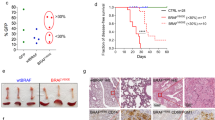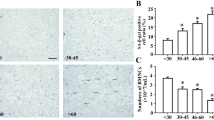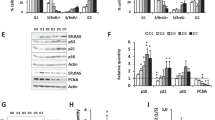Abstract
Previous studies have documented that Tumor necrosis factor alpha (TNFα) is a potent negative regulator of normal hematopoiesis. However, the mechanism by which TNFα acts at the cellular level is not totally understood. Although apoptotic cell killing appears to be the most common cellular effect of TNFα, other studies suggest that this cytokine may elicit other cellular responses such as prolonged growth inhibition. In this context, we have investigated whether TNFα may induce senescence in hematopoietic cells, which display intrinsic defect in the apoptotic machinery. The present study described that, in the leukemic KG1 cells, TNFα induced no apoptosis but a senescence state characterized by prolonged growth arrest, increased β-galactosidase activity, p21WAF-1 induction, decreased telomerase activity, telomeric disturbances (shortening, losses, fusions), and additional chromosomal aberrations. Telomerase inhibition correlated with reduced levels of hTERT transcripts. GM-CSF prevented TNFα effects and allowed leukemic cells to recover growth capacity. Finally, our study shows for the first time that, at least in some hematopoietic cells, TNFα may induce senescence with important functional consequences, including sustained growth inhibition and genetic instability, and that this cellular response is efficiently regulated by hematopoietic growth factors.
This is a preview of subscription content, access via your institution
Access options
Subscribe to this journal
Receive 50 print issues and online access
$259.00 per year
only $5.18 per issue
Buy this article
- Purchase on Springer Link
- Instant access to full article PDF
Prices may be subject to local taxes which are calculated during checkout








Similar content being viewed by others
References
Akiyama M, Hideshima T, Hayashi T, Tai YT, Mitsiades CS, Mitsiades N, Chauhan D, Richardson P, Munshi NC and Anderson KC . (2002). Cancer Res., 62, 3876–3882.
Baloch Z, Cohen S and Coffman FD . (1990). J. Immunol., 145, 2908–2913.
Bettaieb A, Record M, Come MG, Bras AC, Chap H, Laurent G and Jaffrezou JP . (1996). Blood, 88, 1465–1472.
Bryder D, Ramsfjell V, Dybedal I, Theilgaard-Monch K, Hogerkorp CM, Adolfsson J, Borge OJ and Jacobsen SE . (2001). J. Exp. Med., 194, 941–952.
De Maria R, Zeuner A, Eramo A, Domenichelli C, Bonci D, Grignani F, Srinivasula SM, Alnemri ES, Testa U and Peschle C . (1999). Nature, 401, 489–493.
Dimri GP, Lee X, Basile G, Acosta M, Scott G, Roskelley C, Medrano EE, Linskens M, Rubelj I, Pereira-Smith O, Peacocke M and Campisi J . (1995). Proc. Natl. Acad. Sci. USA, 92, 9363–9367.
Dumont P, Balbeur L, Remacle J and Toussaint O . (2000). J. Anat., 197, 529–537.
Dybedal I, Bryder D, Fossum A, Rusten LS and Jacobsen SE . (2001). Blood, 98, 1782–1791.
Gorbunova V, Seluanov A and Pereira-Smith OM . (2002). J. Biol. Chem., 277, 38540–38549 (Epub 2002 July 24).
Jaffrezou JP, Levade T, Bettaieb A, Andrieu N, Bezombes C, Maestre N, Vermeersch S, Rousse A and Laurent G . (1996). EMBO J., 15, 2417–2424.
Jeoung DI, Tang B and Sonenberg M . (1995). J. Biol. Chem., 270, 18367–18373.
Kelly ML, Tang Y, Rosensweig N, Clejan S and Beckman BS . (1998). Blood, 92, 416–424.
Kitagawa M, Saito I, Kuwata T, Yoshida S, Yamaguchi S, Takahashi M, Tanizawa T, Kamiyama R and Hirokawa K . (1997). Leukemia, 11, 2049–2054.
Maser RS and DePinho RA . (2002). Science, 297, 565–569.
Mathieu N, Pirzio L, Freulet-Marriere MA, Desmaze C and Sabatier L . (2004). Cell Mol. Life Sci., 61, 641–656.
Murase T, Hotta T, Saito H and Ohno R . (1987). Blood, 69, 467–472.
Nathan I, Dizdaroglu M, Bernstein L, Junker U, Lee C, Muegge K and Durum SK . (2000). Cytokine, 12, 881–887.
Ogretmen B, Kraveka JM, Schady D, Usta J, Hannun YA, Obeid LM, Wood R, Luberto C and Birbes H . (2001a). J. Biol. Chem., 276, 32506–32514.
Ogretmen B, Schady D, Usta J, Wood R, Kraveka JM, Luberto C, Birbes H, Hannun YA and Obeid LM . (2001b). J. Biol. Chem., 276, 24901–24910.
Oster W, Cicco NA, Klein H, Hirano T, Kishimoto T, Lindemann A, Mertelsmann RH and Herrmann F . (1989). J. Clin. Invest., 84, 451–457.
O'Sullivan JN, Bronner MP, Brentnall TA, Finley JC, Shen WT, Emerson S, Emond MJ, Gollahon KA, Moskovitz AH, Crispin DA, Potter JD and Rabinovitch PS . (2002). Nat. Genet., 32, 280–284.
Park YM, Han MY, Blackburn RV and Lee YJ . (1998). J. Cell. Physiol., 174, 27–34.
Quentmeier H, Dirks WG, Fleckenstein D, Zaborski M and Drexler HG . (2000). Exp. Hematol., 28, 1008–1015.
Quillet-Mary A, Mansat V, Duchayne E, Come MG, Allouche M, Bailly JD, Bordier C and Laurent G . (1996). Leukemia, 10, 417–425.
Sugimoto K, Toyoshima H, Sakai R, Miyagawa K, Hagiwara K, Ishikawa F, Takaku F, Yazaki Y and Hirai H . (1992). Blood, 79, 2378–2383.
Tobler A, Johnston D and Koeffler HP . (1987). Blood, 70, 200–205.
Tsukada Y, Nakamura T, Iimura M, Iizuka BE and Hayashi N . (2002). Am. J. Gastroenterol., 97, 2820–2828.
von Zglinicki T . (2002). Trends Biochem. Sci., 27, 339–344.
Yang J, Chang E, Cherry AM, Bangs CD, Oei Y, Bodnar A, Bronstein A, Chiu CP and Herron GS . (1999). J. Biol. Chem., 274, 26141–26148.
Young NS . (2000). Semin. Hematol., 37, 3–14.
Zhu J, Wang H, Bishop JM and Blackburn EH . (1999). Proc. Natl. Acad. Sci. USA, 96, 3723–3728.
Acknowledgements
This work was supported by grants from the INSERM, the Fondation de France, and the Association pour la Recherche contre le Cancer.
Author information
Authors and Affiliations
Corresponding author
Rights and permissions
About this article
Cite this article
Beyne-Rauzy, O., Recher, C., Dastugue, N. et al. Tumor necrosis factor alpha induces senescence and chromosomal instability in human leukemic cells. Oncogene 23, 7507–7516 (2004). https://doi.org/10.1038/sj.onc.1208024
Received:
Revised:
Accepted:
Published:
Issue Date:
DOI: https://doi.org/10.1038/sj.onc.1208024



